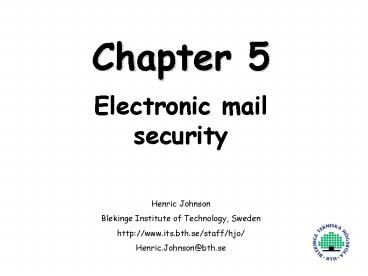Electronic mail security - PowerPoint PPT Presentation
1 / 33
Title: Electronic mail security
1
Chapter 5
- Electronic mail security
- Henric Johnson
- Blekinge Institute of Technology, Sweden
- http//www.its.bth.se/staff/hjo/
- Henric.Johnson_at_bth.se
2
Outline
- Pretty good privacy
- S/MIME
- Recommended web sites
3
Pretty Good Privacy
- Philip R. Zimmerman is the creator of PGP.
- PGP provides a confidentiality and authentication
service that can be used for electronic mail and
file storage applications.
4
Why Is PGP Popular?
- It is availiable free on a variety of platforms.
- Based on well known algorithms.
- Wide range of applicability
- Not developed or controlled by governmental or
standards organizations
5
Operational Description
- Consist of five services
- Authentication
- Confidentiality
- Compression
- E-mail compatibility
- Segmentation
6
(No Transcript)
7
Compression
- PGP compresses the message after applying the
signature but before encryption - The placement of the compression algorithm is
critical. - The compression algorithm used is ZIP (described
in appendix 5A)
8
E-mail Compatibility
- The scheme used is radix-64 conversion (see
appendix 5B). - The use of radix-64 expands the message by 33.
9
Segmentation and Reassembly
- Often restricted to a maximum message length of
50,000 octets. - Longer messages must be broken up into segments.
- PGP automatically subdivides a message that is to
large. - The receiver strip of all e-mail headers and
reassemble the block.
10
Sumary of PGP Services
11
Summary of PGP Services with Description
12
(No Transcript)
13
Format of PGP Message
14
(No Transcript)
15
(No Transcript)
16
(No Transcript)
17
The Use of Trust
- Key legitimacy field
- Signature trust field
- Owner trust field
See Table 5.2 (W. Stallings)
18
(No Transcript)
19
(No Transcript)
20
Revoking Public Keys
- The owner issue a key revocation certificate.
- Normal signature certificate with a revote
indicator. - Corresponding private key is used to sign the
certificate.
21
S/MIME
- Secure/Multipurpose Internet Mail Extension
- S/MIME will probably emerge as the industry
standard. - PGP for personal e-mail security
22
Simple Mail Transfer Protocol (SMTP, RFC 822)
- SMTP Limitations - Can not transmit, or has a
problem with - executable files, or other binary files (jpeg
image) - national language characters (non-ASCII)
- messages over a certain size
- ASCII to EBCDIC translation problems
- lines longer than a certain length (72 to 254
characters)
23
Header fields in MIME
- MIME-Version Must be 1.0 -gt RFC 2045, RFC
2046 - Content-Type More types being added by
developers (application/word) - Content-Transfer-Encoding How message has been
encoded (radix-64) - Content-ID Unique identifying character string.
- Content Description Needed when content is not
readable text (e.g.,mpeg)
24
(No Transcript)
25
(No Transcript)
26
S/MIME Functions
- Enveloped Data Encrypted content and encrypted
session keys for recipients. - Signed Data Message Digest encrypted with
private key of signer. - Clear-Signed Data Signed but not encrypted.
- Signed and Enveloped Data Various orderings for
encrypting and signing.
27
Algorithms Used
- Message Digesting SHA-1 and MDS
- Digital Signatures DSS
- Secret-Key Encryption Triple-DES, RC2/40
(exportable) - Public-Private Key Encryption RSA with key sizes
of 512 and 1024 bits, and Diffie-Hellman (for
session keys).
28
(No Transcript)
29
User Agent Role
- S/MIME uses Public-Key Certificates - X.509
version 3 signed by Certification Authority - Functions
- Key Generation - Diffie-Hellman, DSS, and RSA
key-pairs. - Registration - Public keys must be registered
with X.509 CA. - Certificate Storage - Local (as in browser
application) for different services. - Signed and Enveloped Data - Various orderings for
encrypting and signing.
30
(No Transcript)
31
User Agent Role
- Example Verisign (www.verisign.com)
- Class-1 Buyers email address confirmed by
emailing vital info. - Class-2 Postal address is confirmed as well,
and data checked against directories. - Class-3 Buyer must appear in person, or send
notarized documents.
32
(No Transcript)
33
Recommended Web Sites
- PGP home page www.pgp.com
- MIT distribution site for PGP
- S/MIME Charter
- S/MIME Central RSA Inc.s Web Site































